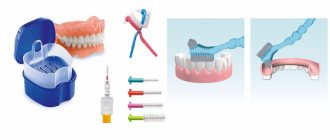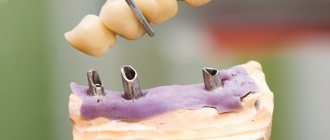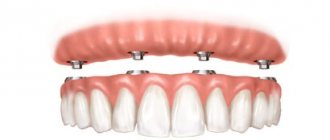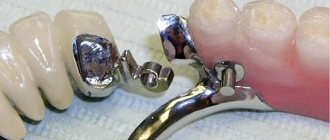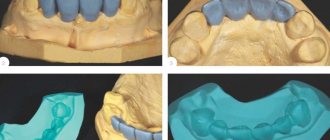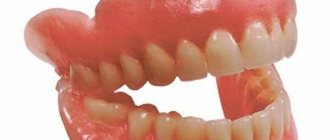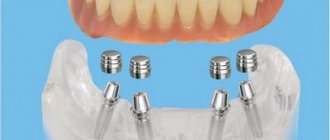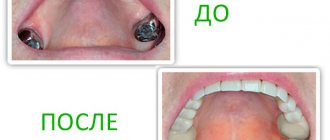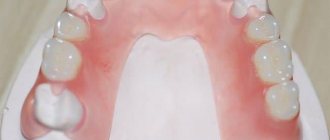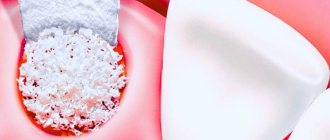Ceramics Metal materials Removable prosthetics Doctors Works
The fight for the beauty of a smile is a battle that is fought until victory. If it is not possible to preserve natural teeth, doctors offer comfortable solutions in orthopedics. Materials for prosthetics allow us to produce a durable, aesthetic replacement.
Recent decades have changed the quality and type of use of materials. In the dashing nineties, the patient’s wealth was the golden shimmer of the crowns. Trends are aimed at naturalness. The once fragile porcelain has become durable and in demand in orthopedics.
- Alekperov R.B. Orthopedic dentist
Question:
Is it true that nylon deteriorates quickly and the prosthesis needs to be replaced?
Answer:
Nylon prosthesis requires careful care using gentle, non-abrasive compounds and a soft brush. If hygiene rules are not followed, the surface of nylon becomes porous and rough. It is not advisable to use such a prosthesis
- Sapronov D.O. orthopedic dentist
Question:
Is ceramic only suitable for anterior teeth?
Answer:
The strength properties of all-ceramic prostheses determine the preferred scope of their application for the frontal zone.
< Previous Next >
Content
- Composite
- Ceramics. Metal ceramics
- Ceramic dentures
- Metal alloys
- Plastic
Modern materials for prosthetics help facilitate this process. Today, dentures are high quality structures that are barely distinguishable from real teeth and are comfortable to wear. They are made from various materials.
Modern prostheses:
- High quality;
- Wearable, with a long service life;
- Aesthetic;
- Ensuring the full functioning of the dental system.
Each of the materials from which dentures are made has its own characteristics.
This group includes:
- Ceramics;
- Metal ceramics;
- Plastic;
- Composites;
- Metal alloys.
The choice of the optimal option is carried out taking into account many factors.
PROMOTION
All-on-4 prosthetics turnkey!
120,000 rub.
What are dentures?
These are unique structures used in dentistry that replace a person’s own teeth. They come in two types: removable and non-removable. The name “removable” speaks for itself: such dentures are removed from the mouth to clean and remove food debris. This is quite convenient, but at the same time, this property can also be considered a disadvantage, because for some, the need to clean the prosthesis every day can be tedious. Therefore, many people resort to permanent dentures. These include:
- Veneers are used mostly to correct aesthetic imperfections of teeth.
- Crowns placed on a tooth to prevent further decay.
- Bridges are several interconnected crowns that are installed when two or more teeth are missing.
Teeth perform a number of very important tasks. In addition to the obvious chewing function, without which people would not be able to chew food as necessary for its normal digestion and smooth functioning of the digestive system, they perform an aesthetic function. A person feels much more confident in communicating with others, having healthy teeth and a beautiful, attractive smile. Therefore, if you have any problems with your teeth, you should not delay treatment. Properly selected dentures can help restore an attractive smile.
What should we do to find a prosthesis that would fully meet our requirements and be comfortable and safe? First of all, you need to know what materials quality products are made from.
Composite
The composite is durable and has a long service life. Its only drawback is the high price. But if you need a prosthesis for life, it makes sense to resolve the issue in favor of this composition. Composite is a polymer with many additives that provide exceptional strength and make artificial teeth look like real teeth.
Prosthetics are carried out according to the following algorithm:
- A polymer composition is applied to the prepared area in layers, giving it the shape of a lost tooth;
- Each layer is dried with a special lamp.
As a result of this build-up, the tooth becomes stronger and regains its lost shape. The doctor may use a pin to strengthen the structure. The pin is installed into the remains of the tooth or directly into the root canal.
Materials for the manufacture of fixed dentures
At this stage, you cannot do without a visit to the dental office, where the orthodontist performs a set of activities:
- A thorough examination of the oral cavity and identification of existing problems;
- Patient visiting the X-ray room. The image will help the specialist determine the condition of the bone tissue and possibly identify gum abnormalities;
- Sanitation of the oral cavity – removal and treatment of remaining teeth, removal of tartar, whitening (at the request of the patient);
- Selection of the shade of the artificial crown, the option of the future prosthesis and material;
- Taking a plaster cast of the jaw, on the basis of which diagnostic and auxiliary prostheses are made;
- Assessment of jaw occlusion and identification of possible deviations using wax rollers;
- Drawing a drawing of the future prosthesis on a diagnostic model;
- Drawing the outline of the frame on the working model, based on the marks of the diagnostic model;
- Contour correction using a parallelometer;
- Trying on the prosthesis and eliminating possible defects;
- Final fitting of the finished product, explanation of the rules of operation and care.
Ceramics. Metal ceramics
Ceramics for many years was considered the main material for prosthetics, despite the lack of high strength. This delicate material deteriorated over time, and prosthetics had to be started all over again. Modern ceramic and metal-ceramic prostheses have changed - they are reliable and strong.
The advantage of the material is lightness. Teeth made from it are almost not felt in the mouth. Aesthetic indicators are the best. Ceramics are used for both molars and front teeth.
When performed professionally, prosthetic structures are durable, their shade, translucency and shape are indistinguishable from natural teeth. The manufacturing process does not require much time and lengthy preparation. Treatment is carried out relatively quickly. Ceramics are suitable for patients prone to allergic reactions.
Ceramic materials are the leader of modern dentistry
Ceramics or porcelain are the only raw materials from which, based on their color and light-refracting properties, it is possible to create a complete copy of natural teeth. The quality of the ceramics plays a role in production. By mixing colors, a similarity to the patient’s natural shade is achieved. And the accuracy of repeating the required shape depends on plasticity.
For metal and non-metal crowns, the clinic’s doctors use raw materials produced in Germany and Japan. The laboratory reduces the time required for prosthetics and the cost of work.
In addition to traditional crowns and bridges, ceramics are used to make inlays. They are used to restore, even if the walls remain. If you are wondering which is better - ceramic or metal inlays, take into account these facts:
- ceramics are hypoallergenic;
- German composites are not inferior to titanium in strength;
- light, translucent ceramics - a replacement for natural ones.
Metal alloys
As a rule, it is a compound of chromium, nickel and cobalt. The advantage of such materials is their increased resistance to mechanical stress.
Disadvantage: high allergenicity. In patients prone to allergic manifestations, adverse reactions occur frequently.
The preferred material is an alloy of platinum, palladium and gold. The prosthesis from it will be:
- Expensive, but safe and durable.
- Be comfortable and give a feeling of naturalness;
- With a ceramic coating, it will completely match the appearance of natural teeth.
Titanium is a popular and most modern solution in prosthetics.
Titanium prostheses:
- Durable;
- Safe;
- Lungs.
The only drawback is the lack of full compliance with aesthetic requirements. Titanium crowns are placed on the far molars. Here they are not visible to others, but they perform their task flawlessly.
Zirconium oxide remains the traditional choice:
- Lasting;
- Stable;
- Biologically compatible and safe;
- Meeting high aesthetic requirements;
- The color matches the natural enamel of the teeth.
Thanks to laser processing, artificial teeth made of zirconium dioxide completely match the natural shape of the tooth being restored.
What is the best material for prosthetics?
As you can see, the choice of modern materials for dentures is quite large. It is impossible to say definitively which material is better, since each is suitable for a specific purpose. For installing crowns on the front teeth, the best materials for dentures are ceramics, and for molars, metal-ceramics or zirconium oxide are more suitable. A specialist will help you choose which denture material is right for you.
Another important question is what is the compatibility of dentures made of different materials with oral tissues? According to medical research, the most biocompatible bases for artificial teeth are ceramics and zirconium dioxide. Such crowns never cause allergies, this is another big advantage.
Technicians' work
This manufacturing stage largely replicates the steps of the clinical process, since they are closely interrelated.
How dentures are made by technicians:
- Making a cast from plaster.
- Making an individual impression tray based on a plaster cast.
- Production of diagnostic and working models.
- Creating a duplicate of the working model.
- Plastering of the working and auxiliary models in the articulation.
- Placement of crowns on a wax base and filling with plastic.
- Replacing the wax with a polymer base.
- Assembly, polishing and grinding of the finished product.
- Sending the finished product to the orthodontist.
Manufacturing stages and installation
The process of creating and installing a permanent prosthetic structure includes the following stages:
- Conducting a detailed examination and determining a treatment plan;
- Elimination of local interference that limits the possibility of carrying out the procedure;
- Creating an impression to form a model that accurately replicates the anatomical structure;
- Laboratory production of an individual prosthesis from the selected material;
- Trying on the finished design and correcting deficiencies that cause discomfort;
- Final installation and fixation of the prosthesis using the selected technique.
The fastenings that ensure a tight and reliable fit are standard clasps, an abutment located on the implant, as well as dental adhesive cement.
Timing of prosthetics
Modern technologies make it possible to complete a full recovery cycle in just one day. In situations where the results of the examination reveal the need for implantation, it is recommended to use the traditional two-stage method, which involves maintaining the time period necessary for the implantation of the artificial base. As a rule, the adaptation period for fabrics ranges from 4 to 6 months - during this time, intermediate structures are installed that restore the visual aesthetics of the row.
Advantages
Some of the benefits provided by permanent structures include:
- Duration of operation (from 10 to 20 years, depending on the technique);
- Reliability and safety of fixation, preventing sudden loss;
- Availability of aesthetic and practical solutions to increase the attractiveness of your smile;
- Ensuring proper distribution of load on the maxillary region;
- Easy hygienic maintenance of the installed product.
The price of fixed dentures consists of several factors, which include the selected technology, material of manufacture and the cost of additional services.
General overview
The classification adopted in dentistry divides all types of replacement structures into two categories: removable and fixed dentures. The second category includes products fixed on a natural base or implant. Unlike removable models, the patient does not need to independently remove the prosthesis for hygienic treatment, and there is no need to fear possible uncomfortable situations associated with unexpected displacement or loss of the structure during communication with others or eating.
